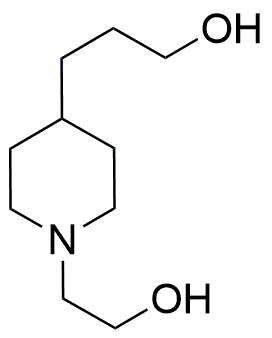1-(2-Hydroxyethyl)-4-(3-hydroxypropyl)piperidine is widely utilized in research focused on:
- Pharmaceutical Development: This compound serves as a key intermediate in the synthesis of various pharmaceuticals, particularly those targeting neurological disorders, enhancing drug efficacy and specificity.
- Cosmetic Formulations: Its moisturizing properties make it a valuable ingredient in skincare products, helping to improve skin hydration and texture, which is essential for beauty and personal care industries.
- Polymer Chemistry: Used as a building block in the production of specialty polymers, it contributes to materials with enhanced mechanical properties and thermal stability, beneficial in manufacturing durable goods.
- Analytical Chemistry: This compound acts as a standard in chromatographic techniques, aiding in the accurate analysis of complex mixtures, which is crucial for quality control in laboratories.
- Biochemical Research: It is employed in studies related to enzyme activity and metabolic pathways, providing insights into biological processes that can lead to advancements in medical research.
General Information
Properties
Safety and Regulations
Applications
1-(2-Hydroxyethyl)-4-(3-hydroxypropyl)piperidine is widely utilized in research focused on:
- Pharmaceutical Development: This compound serves as a key intermediate in the synthesis of various pharmaceuticals, particularly those targeting neurological disorders, enhancing drug efficacy and specificity.
- Cosmetic Formulations: Its moisturizing properties make it a valuable ingredient in skincare products, helping to improve skin hydration and texture, which is essential for beauty and personal care industries.
- Polymer Chemistry: Used as a building block in the production of specialty polymers, it contributes to materials with enhanced mechanical properties and thermal stability, beneficial in manufacturing durable goods.
- Analytical Chemistry: This compound acts as a standard in chromatographic techniques, aiding in the accurate analysis of complex mixtures, which is crucial for quality control in laboratories.
- Biochemical Research: It is employed in studies related to enzyme activity and metabolic pathways, providing insights into biological processes that can lead to advancements in medical research.
Documents
Safety Data Sheets (SDS)
The SDS provides comprehensive safety information on handling, storage, and disposal of the product.
Product Specification (PS)
The PS provides a comprehensive breakdown of the product’s properties, including chemical composition, physical state, purity, and storage requirements. It also details acceptable quality ranges and the product's intended applications.
Certificates of Analysis (COA)
Search for Certificates of Analysis (COA) by entering the products Lot Number. Lot and Batch Numbers can be found on a product’s label following the words ‘Lot’ or ‘Batch’.
*Catalog Number
*Lot Number
Certificates Of Origin (COO)
This COO confirms the country where the product was manufactured, and also details the materials and components used in it and whether it is derived from natural, synthetic, or other specific sources. This certificate may be required for customs, trade, and regulatory compliance.
*Catalog Number
*Lot Number
Safety Data Sheets (SDS)
The SDS provides comprehensive safety information on handling, storage, and disposal of the product.
DownloadProduct Specification (PS)
The PS provides a comprehensive breakdown of the product’s properties, including chemical composition, physical state, purity, and storage requirements. It also details acceptable quality ranges and the product's intended applications.
DownloadCertificates of Analysis (COA)
Search for Certificates of Analysis (COA) by entering the products Lot Number. Lot and Batch Numbers can be found on a product’s label following the words ‘Lot’ or ‘Batch’.
*Catalog Number
*Lot Number
Certificates Of Origin (COO)
This COO confirms the country where the product was manufactured, and also details the materials and components used in it and whether it is derived from natural, synthetic, or other specific sources. This certificate may be required for customs, trade, and regulatory compliance.


